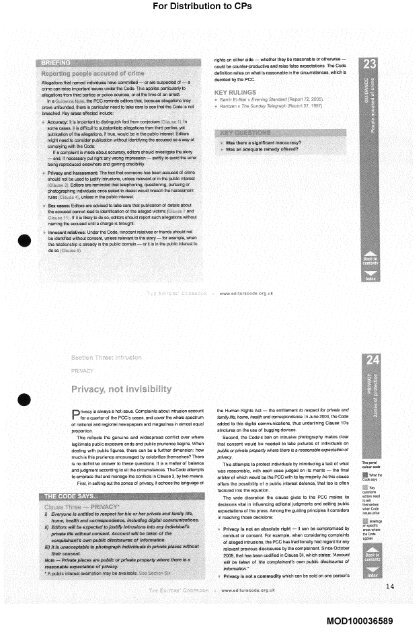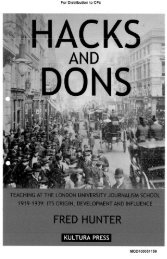The Edi ' - The Leveson Inquiry
The Edi ' - The Leveson Inquiry
The Edi ' - The Leveson Inquiry
You also want an ePaper? Increase the reach of your titles
YUMPU automatically turns print PDFs into web optimized ePapers that Google loves.
For Distribution to CPs<br />
E~nvacy is always a hot issue. Complaints about intrusion account<br />
~for a quarter of the PCC’s cases, and cover the whole spectrurr<br />
of national and regional newsPaders and magazines in almost equal<br />
proeortiot7<br />
This reflects the genuine and widespread conflict over where<br />
legitimate public exposure ends and public prunenca Degas. When<br />
dealing with public figures, there can De a further dimension: how<br />
much is this orunenca encouraged by celebrities themselves? <strong>The</strong>re<br />
rights on either side --- whether they be reasonable or otherwise -could<br />
be counter-productive and raise false expectations. <strong>The</strong> Code<br />
definition refes on what is raasonable in the CircumstanCes; which is<br />
~eoide~ by the Pcc.<br />
i Samil fi-f~tai i Eienii! ,Siiiiir/(fei=~d: 72~ 2[05~,<br />
the Human Rights Act -- the entitlement to respect for private end<br />
famtiylife, home, hea.e.h end correspondence. In June 2004 the Code<br />
added to this digita communications, thus underlining Clause 10’s<br />
stnc~ures on the use of bugging devices<br />
Second, the Cede’s ban on intrusive photography makes clear<br />
~hat consent would De needed to take uictures of individuals on<br />
public or pdvate property where there is a reasonable expectation of<br />
privacy.<br />
is no definitive answer to these questions. It is a matter of balance This attempts to erotect individuals ay introducing a test of what<br />
and judgment according to all the circumstances. <strong>The</strong> Code attempts was reasonaole, with each case judged on its merits -- the final<br />
to embrace that and manage the conflicts in Clause 3, by two means. arbiter of which would be ~he POC with its lay majority. As this clause<br />
First, in setting out the zones of privacy, it echoes the language of offers the possibility of a pubic interest defenca, that too Js often<br />
. Privacy is ~et an absolute right -- it can be compromised by<br />
conduct or consent. For example, when considering complaints<br />
of alleged intrusions, the PCC has traditionaly had regard for any<br />
relevant previous disclosures by the complainant. Since October<br />
2009, that has been codified in Clause 3i, which states: ~ccaunt<br />
will be taken of the complainant’s own public disclosures of<br />
information."<br />
Privacy is ~et a ceraraedity which can be sold on one person’s<br />
Tie panel<br />
ceiour code<br />
~ Wna~ me<br />
Code says<br />
;~. Key<br />
factored into the equation, coast=one<br />
<strong>The</strong> wide discretion the clause gives to the PCC makes ts<br />
aolrorsneeo<br />
Io ask<br />
decisions vital in influencing editorial judgments end setting pubtic themselves<br />
wnen Code<br />
expectations of the press. Among the guiding principles it considers<br />
ssues arise<br />
n reaching those decisions;<br />
~ Briefings<br />
on specific<br />
areas where<br />
[he Cads<br />
MOD100036589<br />
14
















